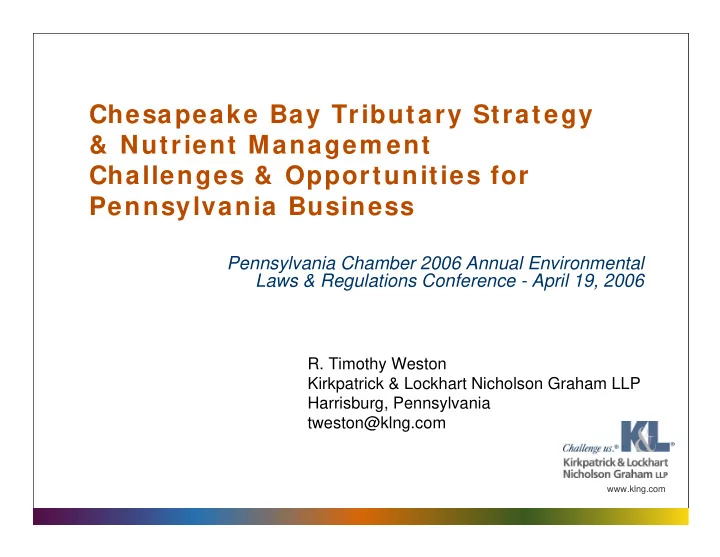

Chesapeake Bay Tributary Strategy & Nutrient Managem ent Challenges & Opportunities for Pennsylvania Business Pennsylvania Chamber 2006 Annual Environmental Laws & Regulations Conference - April 19, 2006 R. Timothy Weston Kirkpatrick & Lockhart Nicholson Graham LLP Harrisburg, Pennsylvania tweston@klng.com www.klng.com
How does the Chesapeake Bay Tributary Strategy affect business? Limits on phosphorus and nitrogen loadings in direct discharges (NPDES limits). Loading limits on local sewage treatment plants Impacts on incoming industrial wastewaters Limits on future expansion & development Limits on new or increased discharge (offsetting credit required). Stricter controls of stormwater management. 2
The Pennsylvania area affected 3
Chesapeake Bay Agreem ent ( 2 0 0 0 ) New water quality goals established, to achieve dissolved oxygen, chlorophyll-a and water clarity objectives. Overall nutrient and sediment reduction objectives: Nitrogen: 285 175 MM lbs. Phosphorous: 19.1 12.8 MM lbs. Sediment: 5.04 4.15 MM tons 4
PA sources of nitrogen and phosphorus 2002 Total = 109,209,000 lb/yr 2002 Total = 3,580,000 lb/yr 5
Pa. Tributary Strategy Issued December 2004. Not adopted as a regulation or a policy. Being implemented by PaDEP without specific rules. Sets strategy for reducing Nitrogen and Phosphorous loads from point and non-point sources by roughly 1/3 each. 6
Controls on existing point sources under strategy ~ 150 existing significant sewage & industrial dischargers identified POTWs/STPs: NPDES permits amended to limit loads of TKN and P load caps based on projected 2010 flows and concentration of 8 mg/l N and 1 mg/l P. Industries NPDES permits to be amended with N and P load caps, based on existing concentrations and future (full capacity) flow rates. Requires, in many cases, monitoring to set values. Timing uncertain. 7
Non-point source control strategies More stringent control of stormwater management, with emphasis on stormwater infiltration PaDEP Comprehensive Stormwater Management Strategy PaDEP Stormwater Management BMP Manual ( under development ) Not clear what actions expected at existing developments, as opposed to new facilities. Largely voluntary controls for agriculture, with reliance on nutrient trading to stimulate progress. 8
Estim ated cost of im plem enting strategy Source 2002 % Estimated Estimated % Loadings Cost of of Control Controls Costs (millions) Point Sources 11 N, 18 P, 0 S $376.4 - 500 4.6% Septic Systems 4 N, 0 P, 0 S $1,600 19.5% Forest 21 N, 3 P, 17 S $ 25 0.3% Mixed Open/Developed 14 N, 15 P, 11 S $5,600 68.4% Stormwater Agriculture 49 N, 63 P, 72 S 593 7.2% 9
New and increased discharges New or increased discharges involving N and P loadings to be allowed only with corresponding reductions (offsets/credits) from existing loading sources. Source of offsets = nutrient trading program 10
PaDEP Nutrient & Sedim ent Reduction Credit Trading I nterim Final Policy & Guidelines PaDEP Doc. 392-0900-001, issued 10/1/2005 Policy adopted without prior notice and public comments Establishes regime for creating and trading credits re: nutrients and sediment loadings in Chesapeake Bay tributary area 11
Thresholds of eligibility for credit generation point sources Reduction in N or P loadings below discharge loading limit expressed in an NPDES permit. Example: Company has NPDES limit of 1500 lb/year of N, and can either control generation or implements better treatment, lowering discharge to 600 lb/year can get credit of 900 lb/year. Problem: can t effectively generate credits until caps are established in NPDES ( don t control too early ) 12
Thresholds of eligibility for credit generation agricultural non-point sources Must have an approved and implemented nutrient management budget for N & P. Must have a minimum 100 foot setback for manure application, or a minimum 35 foot vegetative buffer (or more if required by law or reg) along streams. Credit generation is for activities above and bond what is required for nutrient management budget and minimum setback/buffer requirement. Problem: most agricultural users are not subject to mandate of having nutrient management budget or buffer area so incentives must be provided to undertake to get users to point where they first start to generate credits. 13
Methods for generating tradable credits in agriculture PaDEP s preferred alternatives Forested buffer areas Cover crops Advanced nutrient management Requirements Inspection to assure control is proper siting, plans satisfy established quality specifications and performance standards Annual inspections to ensure continuing functionality Annual account balancing, using seasonal monitoring Developed and implemented maintenance plan 14
Trading credits Trading parameter by parameter (N for N) Credits adjusted for: Uncertainty ratios variation in expected reliability and efficiency of reduction Delivery ratios based on location in basin of credit generation vs. credit use points Retirement ratio general 5% reduction Special needs ratios sensitive waters or other issues Administration ratio not described in policy, but = 5% 15
How are trades accom plished? One-for-one trade by contract between parties, with approval of PaDEP (who must be third party beneficiary of agreement) . PaDEP or Approved Entities (conservation districts) maintain list of entities potentially interested in trade. PaDEP trading website www.dep.state.pa.us/river/river_trading.htm All trades must be registered with PaDEP . Trades made legally enforceable through: NPDES Permit limits Contracts with PaDEP as beneficiary able to enforce 16
I ssues in credit trading Who makes investment to get seller site to threshold of eligibility to begin generating credits? Who makes the investment in activities to create the credit; and who owns the credit (must be specified in contract). What happens when seller does not maintain activities that generated the credit? Buyer or PaDEP may enforce contract. PaDEP takes position that credits are good for each year. If seller ceases BMP actions, buyer may need to seek replacement credits elsewhere => potential for lost capital investment, and need to have ongoing financial incentive to seller. 17
I ssues in credit trading ( con t) Enforcement issues: Covenants and restrictive covenants from seller. Do covenants run with land? Access and inspection. Right to obtain injunctive relief. Liquidated damages for breach. Future changes in land use (change from agriculture) Ultimately, number of credits available is finite; implications for future development in region. 18
Recommend
More recommend